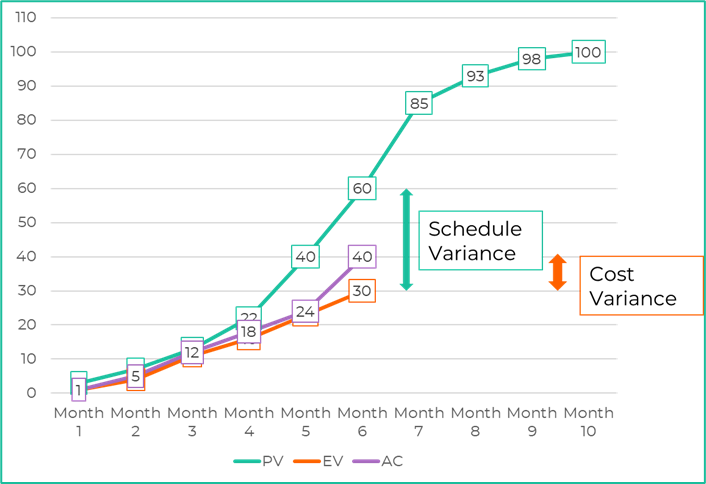
Why I stopped loving Earned Value Management


I have been an advocate for Earned Value Management (EVM) for many years. Its typical S-curves are so clear and insightful that in less than 10 minutes, we can convince most managers of its value.

However, the more we have put this technique into practice, the more evident became its flaws. In this article we will discuss the merits of EVM, its perceived flaws and what I believe the project controls community should learn from both.

It is safe to say that thanks to EVM, many project managers received a much better insight in the performance of their project.
The merits of EVM
EVM has been a game changer for project cost control. Traditionally, project cost control was applied in cost sheets as depicted below.

Then the EVM S-curves came. EVM is an eye-opening approach that integrates scope, time and cost and allows to show the true performance of a project. The technique uncovers and solves some clear issues of traditional project cost control.
What are these strengths of EVM?
- EVM is an integrated approach. Its focus on data structures such as work packages and control accounts helps to integrate time and cost.
- EVM splits the misleading accounting variance (actual vs planned) into a schedule variance and a cost variance. This gives us a better view on the real cost performance.
- EVM allows us to have insight in current performance, while traditional project cost control tends to focus on At Completion. Focusing on current performance has the virtue of being measurable and ‘undisputable’.
- Traditional cost control is vulnerable to wishful thinking and size-to-fit estimating. EVM counters these optimistic PM’s by extrapolating measured performance to forecast the Estimate to Complete (ETC).
- The spirit of Earned Value Management dictates that management reports should be transparent and based on traceable progress measurements. They should also invoke corrective actions.
- EVM manages change. The way how baseline changes and management reserve transfers are used in EVM adds a lot of value.
The flaws of EVM
Over the years, we became increasingly aware that implementing a good EVM system is not as straight-forward as Figure 1 would suggest, especially for large projects that are executed in an uncertain environment.
Being an advocate or not, no one can be blind to some issues that Earned Value Management has:
- It remains in essence a deterministic approach. Both scheduling and cost management have evolved into probabilistic approaches where uncertainties and risks are taken into account. In EVM, progress is compared to a deterministic baseline and whenever this baseline is not met, we report bad performance. In a probabilistic approach, we recognize that not meeting an (optimistic) baseline is an expected outcome and we use (pooled) contingency reserves to cope with uncertainty. EVM metrics are hard to evaluate in such a risk-driven environment.
- The effort required to create a baseline S-curve (or planned value curve) is very large. Establishing a bottom-up cost estimate and cost-loading your schedule with this estimate is a task with a questionable effort / value trade-off.
- The forecasting proposed by EVM is too rough. Extrapolation of current performance to the remainder of the work is seldom the best guess we have for the Estimate to Complete. Traditional cost control often does a better job at this.

Because of its flaws, the true adoption rate of EVM on projects is much lower than you might expect.
The question
The merits and flaws of earned value management are clear. However, the question we are addressing in this blog post is whether we need EVM and its above-mentioned flaws to realize its merits?
Below are some of lessons learned that indicate that I believe that the answer to this question is negative
Learn MoreLessons from EVM
-
The spirit of Earned Value Management, the usage of integrated data structures and the way EVM deals with change are not really linked to Earned Value Analysis itself and can (or even should) be adopted in any project controls approach.
-
The scheduling community has alternative ways (other than SPI (Schedule Performance Index)) to measure (pure) schedule performance - without the need for cost-loading. Alternatives that can even be more easily adapted for risks and uncertainty.
-
CPI (Cost Performance Index) does not require cost-loading. It can be used to measure pure cost performance (instead of accounting variance) without needing full EVM and S-curves. CPI relies on clear measurement of scope percentage complete, which we consider key within project controls as discussed here.
-
Wishful thinking during forecasting can be controlled by an approach that could be described as traditional cost control with lessons from EVM. We therefore heavily rely on TCPI as discussed in this previous post to analyze whether the ETC is realistic given the currently measured performance.
Adding TCPI to the cost sheet -
Turning project cost control into a probabilistic approach is much easier when we forget about the S-curves. Contingency reserve can be seen as a ‘control account’ that is controlled by periodically updating its Estimate to Complete and by having a procedure for budget transfers towards other control accounts whenever a ‘risk occurs’.
Managing contingency reserves -
S-curves are great, but not at all the only way to visualize schedule and cost performance to data-driven project managers.

The spirit of Earned Value Management strongly shaped my views on data-driven project management.
Conclusion
Earned Value Management is an eye-opening approach within project controls. The lessons we learned by applying it over the years have been countless. It is certain that no other technique has impacted Proove’s way of working more than EVM.
In some cases, EVM is a perfect technique. For more complex and uncertain projects, we feel that it starts to lose its magic and that the effort to implement EVM successfully becomes too demanding.
Rather than enforcing EVM or ignoring EVM in these situations, we choose for an approach where many virtues of EVM can be obtained without paying its price. Even if that means saying goodbye to the wonderful S-curves.



